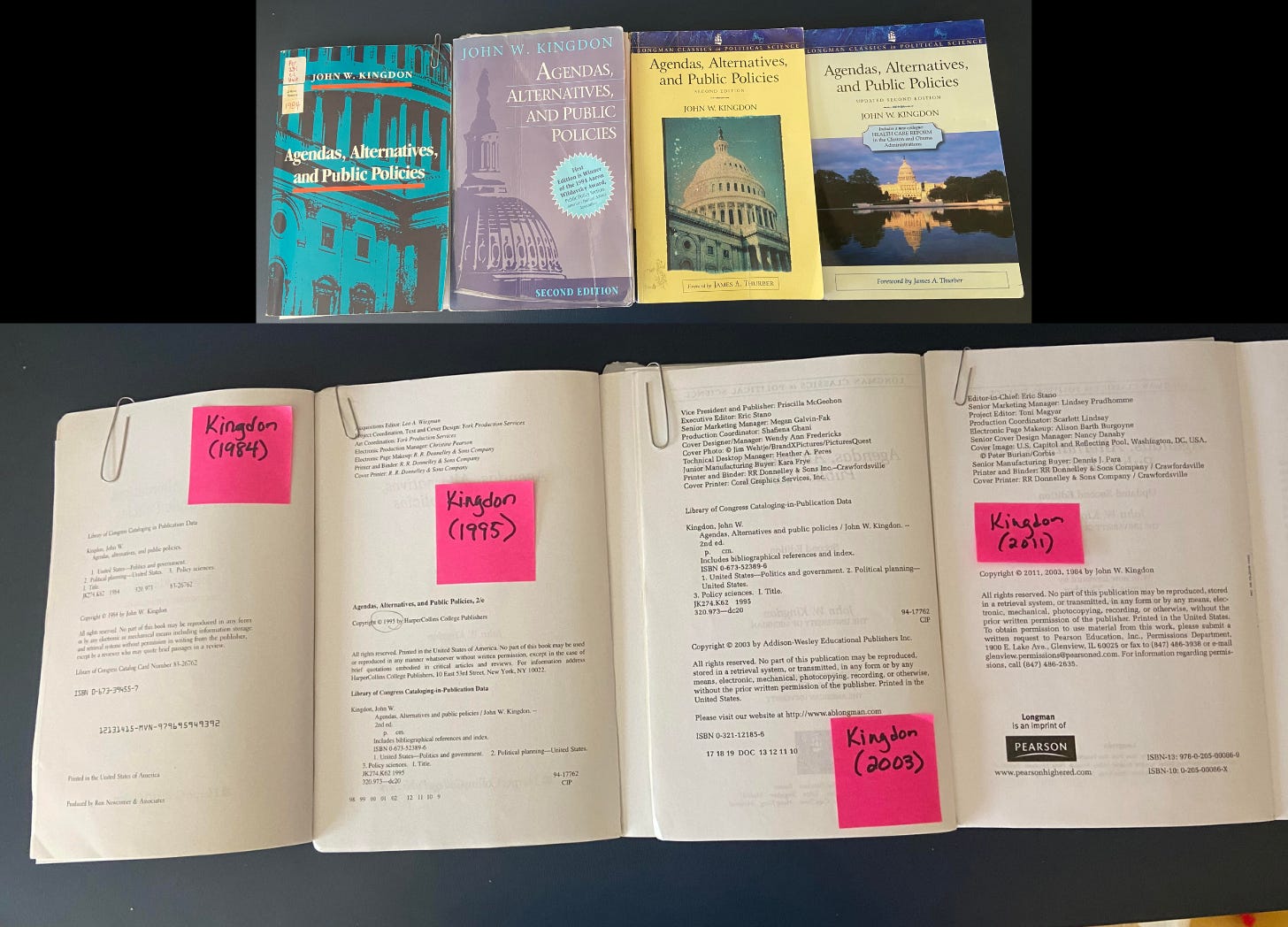QUESTION: How should I cite Kingdon's book, "Agendas, Alternatives, and Public Policies"?
Best practice is to cite the specific edition you are actually using, while acknowledging the original publication date. Here's what this looks like.
When I teach my graduate course on the public policy process, I like to introduce John W. Kingdon in a humanizing way, establishing the context in which he wrote his influential book so we can talk about the important events of the day that may have influenced his writing. Like the moon launch analogy he used on page 166. Based on his birthday, October 28, 1940, he was 28 when Neil Armstrong walked on the moon. This world-shaking event must have had a deep influence on his thinking. It helps to understand his perspective when you consider the world he lived in.
As part of my classroom ode to Kingdon, I also include a slide with covers of all the books he wrote, including each separate publication of his most famous one. At first I did this to assure students that they had purchased the correct book, and it served everyone well for that purpose. But it also drives home the continuing influence of the “old” book I assign. Here’s my slide:

At some point in the semester, a student will inevitably ask: What version of Kingdon's book, Agendas, Alternatives, and Public Policy do you want us to cite?
It’s a fair question with a non-obvious answer. My students books all look different, with different dates and publishers. That’s because I encourage students to buy any second edition with a nice price. They only vary in their prefaces and appendices, so page references are valid for the portions of the book we use. In fact, I’m sure of this because I have four of the five versions in my personal library.

So, which edition of the book should YOU cite?
The general answer is to cite whatever version of the book you have (that’s tricky for me!). Others say to cite the earliest publication (1984, the 1st edition?). Still others cite the earliest date for the 2nd edition (1995, that’s been my preference). I suppose some prefer citing the very most recent printing (2013, Pearson’s international edition), though I don’t recalling seeing this. I have also seen combinations of dates pointing to multiple entries in the bibliography, like Kingdon (1984, 2011). So, there’s no real consistency, even in published scholarship. You’d think people would have come to some consensus after 34,712 citations (according to Google Scholar, 3/19/2025)!
Here’s what I recommend:
For in-text citations: Use the format "Kingdon ([1984] Year-of-the-edition-you’re-reading)"
In your reference list, provide full details of the edition you're using, then add the original publication date in square brackets before the cited edition’s date.
So, using APSA formatting, if you’re reading the 2003 second edition from Addison-Wesley, your in-text citation would look like this: (Kingdon, [1984] 2003).
Your reference list would include the corresponding entry shown at #3 in the this list (based on my copies, and using APSA style):
Kingdon, John W. 1984. Agendas, Alternatives, and Public Policies. HarperCollins.
Kingdon, John W. [1984] 1995. Agendas, Alternatives, and Public Policies, 2nd ed. New York, NY: HarperCollins.
Kingdon, John W. [1984] 2003. Agendas, Alternatives, and Public Policies. Second Edition. New York, NY: Addison-Wesley.
Kingdon, John W. [1984] 2011. Agendas, Alternatives and Public Policies. Updated Second Edition. New York: Longman.
Sorry, I don’t own the very latest printing: “Pearson’s Update Edition (With an Epilogue on Health Care), Pearson New International Edition” published by Pearson (November 1, 2013) © 2014.
Quick Formatting Tip: In Microsoft Word on a PC, you can use “CTRL-t” to format your bibliography entries with a hanging indent (first line at the margin, wrapping lines indented).
OK, which edition of the book will *I* cite?
With four different copies at hand, which one do I cite? Initially, I wanted to give credit to the earliest version of Kingdon’s ideas (Kingdon, 1984), but I often cite page numbers, so I have to use one of the second editions. Combining these goals, I used the year for the earliest second edition (Kingdon, 1995). After my research for this post, I’m happy to add [1984] to be even more accurate (Kingdon, [1984] 1995). And that got me thinking: with that explicit acknowledgement of the book’s first edition “birthyear,” I can also acknowledge the lasting impact of his book by citing most recent printing in my position: the 2011 “updated second edition.” This “bookend” approach seems to me the most accurate and useful for readers who don’t know the long story of these book printings.
So from now on, my in-line citations will look like this: (Kingdon, [1984] 2011), or with page numbers, like this: (Kingdon, [1984] 2011, pp. 223-224). My reference list entry will look item #4 in the list above.
This approach balances accuracy, giving credit to the original work, providing readers with information about the specific edition I used, and hinting at the book’s ongoing relevance. Note that if you're referencing content specific to a particular edition (e.g., new prefaces or appendices), you should clarify this in your text or footnotes. The approach addresses the issue of multiple editions with different publishers and dates while maintaining consistency across citations.
One more bit of citation advice
Whatever you do, don’t be fooled by Google Scholar’s inaccurate search results that give co-authorship credit to Eric Stanos or James Thurber. They did not help John W. Kingdon write any of his books. Kingdon seemed to prefer sole authorship for all of his books. Perhaps he was a bit of a perfectionist? If so, I’d say we’re all better off because of it.
Who are these two gentlemen? Dr. James A. Thurber , now professor emeritus at the American University, authored a forward that is included in Kingdon’s 2003 second edition and the 2011 updated second edition, both part of the Longman Classics in Political Science. If you want to cite Thurber’s forward, follow the suggestions for citing a book chapter. Eric Stano is listed in Kingdon’s 2003 edition as Executive Editor, and as Editor-in-Chief in the 2011 edition. According to Stano’s LinkedIn profile, he is now VP at Magic EdTech. I wish them both well!
Wondering about Little, Brown or Paul Quirk or Amber Lovell? I’ll leave those mysteries for you to solve.
The takeaway lesson is: be suspicious of algorithms, including Google Scholar’s.




